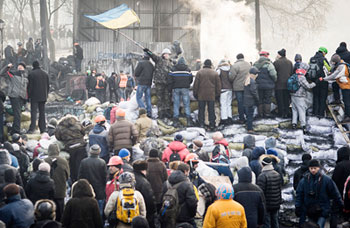

Vol. 78/No. 5 February 10, 2014

|
| Associated press |
| Government repression has galvanized opposition to President Viktor Yanukovich and Russian domination as actions spread across Ukraine. Above, protesters at barricades in Kiev, Jan. 26. |
The motor force behind the protests is the national aspirations of the Ukrainian people, who — with the exception of the early years of the Russian Revolution under the Bolshevik leadership of V.I. Lenin — have lived under Russian domination for centuries.
In the east and south, thousands have joined actions in Odessa, Dnipropetrovsk and Luhansk. In Zaporizhya, 5,000 laid siege to the regional government administration building.
President Yanukovich has begun offering government posts and political concessions to leaders of the opposition, who themselves appear to have less and less control over the spreading protests. Justice Minister Olena Lukash hinted Jan. 26 at declaring a state of emergency, but there has been no attempt to impose one.
Protests began in November when Yanukovich, faced with threats and substantial economic incentives from Russian President Vladimir Putin, backed off from signing an “association” agreement with the European Union. The biggest actions have been in Kiev, the capital, several numbering more than 100,000.
On Jan. 16 the government responded to mounting protests by passing new repressive laws and deploying cops and security forces. At least three people were killed and hundreds injured in the ensuing clashes in the capital.
Government repression has only strengthened protesters’ determination to bring down the regime. For weeks Kiev’s Independence Square has been occupied, protected by barricades of burnt-out police buses, tires and other debris.
As of Jan. 26, government buildings have been occupied in 10 of Ukraine’s 25 regions. Repressive legislation restricting protests was repealed in a Jan. 28 emergency Parliament meeting. Prime Minister Mykola Azarov and his ministers resigned.
The Putin government responded with threats Jan. 28 to renege on promises of $15 billion in financial aid and gas at preferential prices.
Standard & Poor’s cut Ukraine’s credit ratings, calling the regime a “distressed civil society with weakened political institutions.”
The eastern and southern parts of Ukraine, where protests have spread over the past week, represent the industrial heartland of the country. The Donbass region in the southeast, for example, accounts for one-fifth of Ukraine’s industrial production and export revenues, concentrated in mining and steel. These regions near the Russian border have the closest economic and cultural ties to Russia. Speakers of the Russian language make up 24 percent of Ukraine’s population, in some areas in the east it’s as much as 40 percent.
Serhiy Nihoyan, 21, was one of the protesters killed in the clashes in Kiev. Some 1,000 people attended his funeral in a village outside the eastern city of Dnipropetrovsk Jan. 26. “My son died for Ukraine,” his father, an Armenian immigrant, was quoted as saying in the local media.
The national protest movement has drawn other oppressed nationalities into the streets with their own demands, including the Crimean Tatars of Ukraine’s southeastern peninsula, among others.
Among the heterogeneous anti-government demonstrators are several ultrarightist currents — some fielding paramilitary groups — that seek to claim the mantle of the national struggle, including Svoboda, which has members in Parliament; Common Cause; and the Ukrainian National Assembly.
Russian Revolution advance for oppressed nations
Among the central tasks of the 1917 Russian Revolution under the leadership of Lenin was the emancipation of oppressed peoples. In November 1919 the Central Committee of the Russian Communist Party stated that Bolsheviks in Ukraine “must put into practice the right of the working people to study in the Ukrainian language in all Soviet institutions; they must in every way counteract attempts at Russification that push the Ukrainian language into the background.” This policy was decisive in winning Ukrainian working people to the proletarian revolution and voluntary association of Soviet socialist republics.This course was reversed when a growing privileged layer centered in the state bureaucracy headed by Josef Stalin rose to power after Lenin’s death in 1924. They resurrected the Great Russian chauvinism of the tsarist empire and through bloody counterrevolution trampled over rights and aspirations of oppressed peoples. Russification — a policy begun under the empire to resettle Russians in Ukraine — was resurrected.
Events today are a continuation of a deeply rooted struggle against the Russian boot.
Front page (for this issue) |
Home |
Text-version home